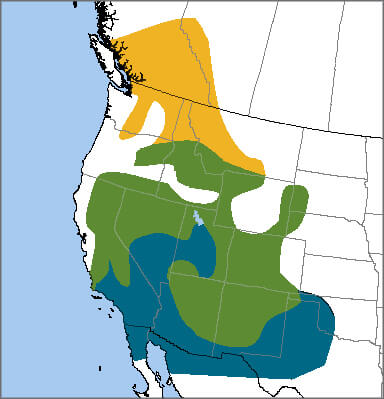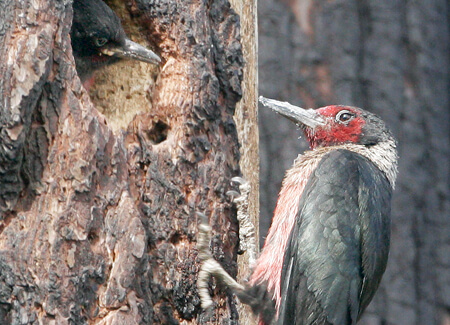 Lewis's Woodpecker was first noted by Meriwether Lewis during the historic Lewis and Clark expedition, and later was officially named and described by famed ornithologist Alexander Wilson. This unusual woodpecker is notable for its flycatching habits and iridescent dark green, silver, and pink plumage.
Lewis's Woodpecker was first noted by Meriwether Lewis during the historic Lewis and Clark expedition, and later was officially named and described by famed ornithologist Alexander Wilson. This unusual woodpecker is notable for its flycatching habits and iridescent dark green, silver, and pink plumage.
Habitat loss and degradation due to fire suppression, especially in ponderosa pine forests and other open forest with snags, are major threats to this species. Pesticide spraying may reduce its food supplies or affect the birds themselves.
The Flycatcher Woodpecker
In the summer, Lewis's Woodpeckers eat mostly insects, catching them in flight by swooping out from a perch like a flycatcher or by foraging in flight like a swallow. Their wide, rounded wings give them a buoyant, straight-line flight, more like a jay or crow than a woodpecker.
The birds seldom excavate for wood-boring insects; unlike other woodpeckers such as Brazil's Kaempfer's Woodpecker, this species lacks the strong head and neck muscles needed to drill into hard wood.
In the fall, Lewis's Woodpeckers switch to eating nuts and fruit, chopping up acorns and other nuts and caching them in bark crevices for later consumption. During the winter they aggressively guard these storage areas against intruders, including other woodpecker species.
Sign up for ABC's eNews to learn how you can help protect birds
Recycled Nesting
Like all other woodpeckers, Lewis's requires cavities in snags (standing, dead, or partly dead trees) for nesting. Since they lack the features required for excavating, these birds tend to choose trees that are already well-decayed. Even so, they rarely if ever excavate the holes themselves, instead re-using a cavity made by another bird or animal.

Lewis's Woodpecker at nest hole with young by Tom Grey
After lining the hole with wood chips, the female lays a clutch of 5 to 9 eggs. The male incubates at night, while both adults alternate egg-sitting during the day. After the hatchings fledge and leave the nest, they remain nearby for at least 10 days, continuing to be fed by the adults during this time.
Plans to Preserve Ponderosa
Surveys indicate that Lewis's Woodpecker populations may have declined by about 60 percent since the 1960s, likely due to loss or alteration of suitable nesting habitat. Over the last 10 years, ABC has made significant investments in the conservation of Lewis's Woodpecker and other cavity-nesting birds, including Flammulated Owl and Williamson's Sapsucker, on private ponderosa pine lands in the Pacific Northwest. ABC has issued several publications to help landowners conserve habitat for cavity-nesting birds throughout the West, and specifically in the Pacific Northwest.
In another recent contribution to conservation of Lewis's Woodpecker, we supported The Columbia Land Trust in the purchase of an important tract of land. The 2016 acquisition was the final parcel in a 418-acre wildlife corridor that shelters prime Lewis's Woodpecker habitat in Oregon.
Donate to support ABC's conservation mission!



















































